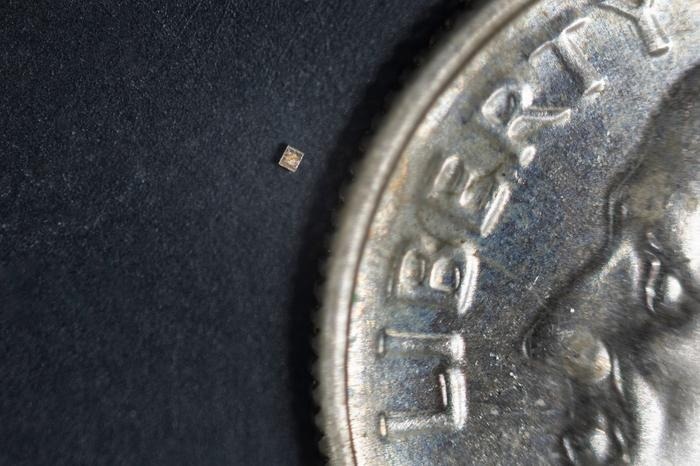Mar 21 2024Reviewed by Lexie Corner
Researchers from Brown University are making significant strides with wireless sensor technology in biomedical microdevices.
 The sensors transmit, receive, and decode data from thousands of microelectronic chips that are each no larger than a grain of salt. Image Credit: Nick Dentamaro/Brown University
The sensors transmit, receive, and decode data from thousands of microelectronic chips that are each no larger than a grain of salt. Image Credit: Nick Dentamaro/Brown University
The research team revealed a novel method for a wireless communication network that can effectively send, receive, and decode data from thousands of tiny microelectronic chips, each no bigger than a grain of salt. The study was published in Nature Electronics.
The sensor network is made so the chips can be worn in wearable technology or inserted into the body. Each silicon sensor is smaller than a millimeter and imitates the electrical activity spikes that neurons in the brain use to communicate. The sensors save energy and bandwidth by detecting specific events as spikes and using radio waves to wirelessly transmit the data in real time.
Our brain works in a very sparse way. Neurons do not fire all the time. They compress data and fire sparsely so that they are very efficient. We are mimicking that structure here in our wireless telecommunication approach. The sensors would not be sending out data all the time — they’d just be sending relevant data as needed as short bursts of electrical spikes, and they would be able to do so independently of the other sensors and without coordinating with a central receiver. By doing this, we would manage to save a lot of energy and avoid flooding our central receiver hub with less meaningful data.
Jihun Lee, Postdoctoral Researcher and Study Lead Author, Brown University
A common issue with current sensor communication networks is that they all must be perfectly synced for the system to function. This radiofrequency transmission scheme solves this issue and also makes the system scalable.
Since electronic sensors are now widely used in modern technology, the researchers believe that their work represents a significant advancement in large-scale wireless sensor technology and could influence how scientists gather and interpret data from these tiny silicon devices in the future.
We live in a world of sensors. They are all over the place. They're certainly in our automobiles; they are in so many places of work and increasingly getting into our homes. The most demanding environment for these sensors will always be inside the human body.
Arto Nurmikko, Professor and Study Senior Author, Carney Institute for Brain Science, School of Engineering, Brown University
According to the researchers, the system may contribute to laying the groundwork for developing upcoming wearable and implantable biomedical sensors. Microdevices that are effective, inconspicuous, and function as a part of large ensembles to map physiological activity over a broad area of interest are becoming increasingly necessary in medicine.
Lee said, “This is a milestone in terms of actually developing this type of spike-based wireless microsensor. If we continue to use conventional methods, we cannot collect the high channel data these applications will require in these kinds of next-generation systems.”
The sensors can detect and transmit specific events, such as changes in the monitored environment, like temperature variations or the detection of particular substances.
The sensors are powered wirelessly by external transceivers that transmit data, so they only need to be near the transceiver's energy waves to obtain a charge. This allows the sensors to operate with minimal energy consumption. Their convenience and versatility for use in various settings stem from their ability to function without requiring a power source or battery.
The team went through multiple fabrication iterations to create the sensors after designing and simulating the intricate electronics on a computer. The research expands upon earlier findings from Brown University’s Nurmikko lab, which presented a novel class of neural interface system known as “neurograins.” This system records and stimulates brain activity via a synchronized network of tiny wireless sensors.
Nurmikko said, “These chips are pretty sophisticated as miniature microelectronic devices, and it took us a while to get here. The amount of work and effort that is required in customizing the several different functions in manipulating the electronic nature of these sensors — that being basically squeezed to a fraction of a millimeter space of silicon — is not trivial.”
The effectiveness of the system and the extent to which it could be expanded were both demonstrated by the researchers. In the lab, they tested the system with 78 sensors and discovered that, even in situations where the sensors were transmitting at different times, they could still collect and send data with minimal errors. They were able to demonstrate, through simulations, how to interpret information taken from monkey brains using roughly 8,000 fictitiously implanted sensors.
According to the researchers, the system will be optimized for lower power consumption in the future, and more applications outside of neurotechnology will be investigated.
“The current work provides a methodology we can further build on,” Lee said.
The National Institutes of Health provided funding for this work. Along with Lawrence Larson and Farah Laiwalla, two faculty members at Brown, Vincent Leung from Baylor University and Miguel Lopez Gordo from the University of Granada are also co-authors.
Journal Reference:
Lee, J., et al. (2024) An asynchronous wireless network for capturing event-driven data from large populations of autonomous sensors. Nature Electronics. doi.org/10.1038/s41928-024-01134-y
Source: https://www.brown.edu/